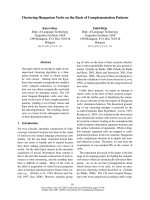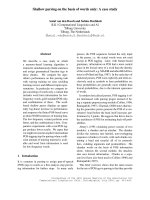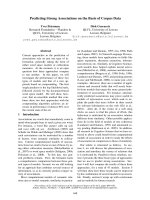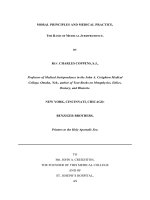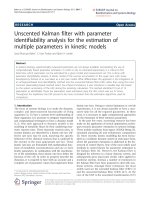The method max min on the basis of given parameters Sayan Mukherjee, Kolkata
Bạn đang xem bản rút gọn của tài liệu. Xem và tải ngay bản đầy đủ của tài liệu tại đây (226.93 KB, 13 trang )
On Maximization of
cyc
(a − b) on the basis of
given parameters
Sayan Mukherjee, Kolkata
June 2, 2012
1
Contents
1 Introduction 3
1.1 Pre-requisites . . . . . . . . . . . . . . . . . . . . . . . . . . . . . 3
2 The |(a − b)(b − c)(c − a)| problem 4
2.1 Determining the Equality Case . . . . . . . . . . . . . . . . . . . 4
2.2 Significance of the Double Root . . . . . . . . . . . . . . . . . . . 4
2.3 The Equality Case . . . . . . . . . . . . . . . . . . . . . . . . . . 5
2.4 Determining the Coefficients for AM-GM . . . . . . . . . . . . . 5
3 Determination of Best Constants 6
4 Fifth Degree Inequalities 7
4.1 Problem 1. . . . . . . . . . . . . . . . . . . . . . . . . . . . . . . 7
4.1.1 Determination of k and other coefficients . . . . . . . . . 7
4.1.2 Main Proof . . . . . . . . . . . . . . . . . . . . . . . . . . 7
4.1.3 Remarks . . . . . . . . . . . . . . . . . . . . . . . . . . . . 8
4.2 Problem 2. . . . . . . . . . . . . . . . . . . . . . . . . . . . . . . 8
4.2.1 Determination of k and Everything Else . . . . . . . . . . 8
4.2.2 Main Proof . . . . . . . . . . . . . . . . . . . . . . . . . . 9
4.2.3 Remarks . . . . . . . . . . . . . . . . . . . . . . . . . . . . 9
5 Other Applications 10
5.1 Problem 1 . . . . . . . . . . . . . . . . . . . . . . . . . . . . . . . 10
5.2 Problem 2 . . . . . . . . . . . . . . . . . . . . . . . . . . . . . . . 10
6 Exercises 12
6.1 Problems . . . . . . . . . . . . . . . . . . . . . . . . . . . . . . . 12
6.2 Answers . . . . . . . . . . . . . . . . . . . . . . . . . . . . . . . . 13
2
1 Introduction
Most inequalities that we come across have a simple type of equality case, ie
a = b = c or a = b, c = 0. But when we think of maximizing the product
(a − b)(b − c)(c − a) or its magnitude (both mean the same), the equality case
cannot be as simple as (1, 1, 1) because any two equal values of a and b can
change the value of this expression directly to zero. Of course, considering
the same thing over nonnegative reals and whole of reals is much different.
So these types of inequalities usually have different equality cases which are
not so obvious to determine. However, we will demonstrate how most of these
inequalities can be easily solved with the help of AM-GM Inequality. After that,
we will try to determine some general forms of this maximum, for different fixed
parameters.
1.1 Pre-requisites
Here we assume that the reader has a good idea of the different ways of apply-
ing the AM-GM inequality, and the Cauchy-Schwarz inequality. These are the
most basic and classical inequalities having monstrous applications. Also some
basic knowledge about the pqr and uvw methods might come in handy, so that
the reader can relate between these stuff easily. Basic knowledge on calculus,
derivatives and solving polynomial equations is also required.
3
2 The |(a −b)(b −c)(c − a)| problem
We will discuss this method by considering a well-known problem of Tran Quoc
Anh(forum name, Nguoivn) which runs as follows.
• If a, b, c ≥ 0, then we have
(a + b + c)
3
≥ 6
√
3|(a − b)(b − c)(c − a)|.
2.1 Determining the Equality Case
Firstly, we have to order a, b, c so as to remove the modulus sign. Also, note
that in these inequalities, it’s important to figure out an equality case somehow.
In most of the cases, the equality occurs when one of the variables is set to zero.
This is due to the nature of (c − a)(c − b)(b − a) (assuming c ≥ b ≥ a.) When
a is the minimum of the three numbers, we see that the expression itself is a
decreasing function in terms of a, if we keep b, c fixed. So this expression will
be able to reach its maximum for a given value of b, c if and only if a is as small
as possible, which is zero itself. Plugging in a = 0 and c = bt leads us to the
cubic equation
(t + 1)
3
= 6
√
3t(t − 1).
A factorisation of this cubic expression gives us
t −
√
3 − 2
2
(t + 7 − 4
√
3) = 0;
Which leads us to the positive double root t =
√
3 + 2.
2.2 Significance of the Double Root
The inequality that we get after putting a = 0 under the assumption c ≥ b ≥ a
is
(b + c)
3
≥ 6
√
3bc(c − b).
Note that in this inequality, when the equality occurs for some value of
c
b
, the
curve (t + 1)
3
−6
√
3t(t −1) must be just touching the t axis at that point, so as
to satisfy the inequality. Another consequence of this concept is that the other
root will be on the negative side of the t axis. Now, we can differentiate this
equation to get the double root easily.
(t + 1)
3
− 6
√
3t(t − 1)
= 3(t + 1)
2
−12
√
3t −1 = 3(t −2 −
√
3)(t + 4 − 3
√
3)
Now, we can check that which one of these is our double root by just plugging
in these values into the previous equation.
4
2.3 The Equality Case
If we see that c =
√
3 + 2
b satisfies the conditions of equality, then the actual
equality case turns out to be
(a, b, c) =
0, 1, (2 +
√
3)
≡
0,
√
3 − 1,
√
3 + 1
The writing as conjugate surds is for aesthetic satisfaction.
2.4 Determining the Coefficients for AM-GM
Once we have determined the equality case, the rest is somewhat easy. Assuming
that c ≥ b ≥ a helps us writing
|(a − b)(b − c)(c − a)| ≤ bc(c − b);
And (a + b + c) ≥ (b + c); So that it is sufficient to check that
(b + c)
3
≥ 6
√
3bc(c − b).
For this, we need to apply AM-GM in such a way that the three terms we choose
on the right hand side are balanced. Using the equality case, we see that
(
√
3 + 1)b = (
√
3 − 1)c = c − b = 2,
And therefore the terms have been determined.
2bc(c − b) =
√
3 + 1
b
√
3 − 1
c
[(c − b)] ≤
√
3(b + c)
3
27
=
(b + c)
3
3
√
3
.
Since we have determined the equality case, therefore we need not worry about
the right hand side. This method works mostly without fail, and is easy to
implement. So, the method has worked out for 6
√
3. We will discuss some
more applications of this method. However, note that higher the degree of the
inequality, the more unusable this method becomes.
5
3 Determination of Best Constants
In cases, these |(a − b)(b − c)(c − a)| problems come with some determination
of the ”best constant” phrases. What it actually means is, say, we were talking
of the inequality
(a + b + c)
3
≥ k|(a − b)(b − c)(c − a)|.
Where k is some positive real number, and a, b, c ≥ 0. In such a problem, they
want us to figure out the largest value that k can attain, because the inequality
implies k ≤
(a + b + c)
3
|(a − b)(b − c)(c − a)|
. If this is satisfied for all a, b, c ≥ 0, then we
might try to minimize the right side first by minimizing a, ie putting a = 0 and
c = tb where t ≥ 1. Then this rewrites into
k ≤
(t + 1)
3
t(t − 1)
.
This is a single-variable inequality, so we may just want to differentiate this to
find the minimum of f(t) =
(t + 1)
3
t(t + 1)
. Simple calculus gives us the value k = 6
√
3
for t = 2 +
√
3. This way can also help us determine the equality case as we
saw in the previous section. For some applications, we can get our hands on
some problems. Note that this is, in cases, not complete enough to prove the
original problem. There may be some other paramatrization in the problem, for
example, an extra (ab + bc + ca) term may be there, thus affecting the nature of
the |(a −b)(b −c)(c −a)| term, which was always decreasing in min{a, b, c}. But,
this can always fetch us the best constants, and the equality cases in a packed
fashion, so that the application of AM-GM becomes easier.
1
So, let’s continue
with some fifth degree inequalities involving the |(a − b)(b − c)(c − a)| term.
1
Caution: In an exam, we never mention the differentiations etc, just scribble the AM-GM
step. All of this should be rough work.
6
4 Fifth Degree Inequalities
4.1 Problem 1.
For nonnegative reals a, b, c, find the best k satisfying
(a + b + c)
5
≥ k(ab + bc + ac)(a − b)(b − c)(c − a)
Tran Quoc Anh, from ”Topic of Nguoivn”
4.1.1 Determination of k and other coefficients
Put a = 0 and c = bt without any hesitation to get (t + 1)
5
≥ kt
2
(t − 1); and
quickly consider f(t) =
(t + 1)
5
t
2
(t − 1)
. We see that
f
(t) =
2(t + 1)
4
(t
2
− 3t + 1)
t
3
(t − 1)
2
;
Which becomes zero at t =
3 ±
√
5
2
. Plugging this in leads to k = 25
√
5, and
the equality case is (a, b, c) =
0,
√
5 − 1,
√
5 + 1
.
4.1.2 Main Proof
WLOG assume that c ≥ b ≥ a. Putting a = 0, b =
√
5 − 1
2
, c =
√
5 + 1
2
; we
obtain k = 25
√
5. So we have to prove that
(a + b + c)
5
≥ 25
√
5(ab + bc + ca)(b − a)(c − b)(c − a).
Note that
(ab + bc + ca)(bc − ca)(bc − ab) ≤
1
27
(ab + bc + ca + bc − ca + bc − ab)
3
= b
3
c
3
;
So that we get
(ab + bc + ca)(c − a)(b − a) ≤ b
2
c
2
.
Hence it is sufficient to check that
(a + b + c)
5
≥ 25
√
5b
2
c
2
(c − b).
Note that, from the AM-GM inequality, we have
b
2
c
2
(c − b) =
√
5 + 1
2
b
2
√
5 − 1
2
c
2
(c − b)
≤
b(
√
5 + 1) + c(
√
5 − 1) + (c − b)
5
5
=
(b + c)
5
25
√
5
≤
(a + b + c)
5
25
√
5
.
7
Equality holds if and only if a = 0, b =
√
5 − 1
2
k, c =
√
5 + 1
2
k, (where k is a
positive constant) and its relevant permutations.
4.1.3 Remarks
The reason why the calculus approach is not a standalone is that our intuition
tells us that the function
(a + b + c)
5
(ab + bc + ca)(c − a)(b − a)(c − b)
is decreasing, and
we actually need to prove somehow that it’s the case. In this problem, we used
simple AM-GM, but it is also possible to show with the help of calculus, ie
just differentiating wrt min{a, b, c} and showing the derivative to be negative
works. However, in most of the cases, such measures are not necessary. The
(ab + bc + ca) factor created problems due to the presence of (ab + ca), which
could be removed by the previous method. Now, let’s try and tackle a
2
+b
2
+c
2
in a similar fashion.
4.2 Problem 2.
For nonnegative reals a, b, c, find the best k satisfying
(a + b + c)
5
≥ k(a
2
+ b
2
+ c
2
)(a − b)(b − c)(c − a)
Tran Quoc Anh, from ”Topic of Nguoivn”
4.2.1 Determination of k and Everything Else
Again, without hesitation, differentiate f(t) =
(t + 1)
5
t(t − 1)(t
2
+ 1)
to get
f
(t) =
(t + 1)
4
(t
4
− 6t
3
+ 6t
2
− 6t + 1
t
2
(t − 1)
2
(t
2
+ 1)
2
;
The next challenge is to factorise t
4
− 6t
3
+ 6t
2
− 6t + 1. Note that we can
factor this into
t
2
+ αt + γ
t
2
+ βt +
1
γ
, After some calculations, we can
rightaway get the factorisation as
t
4
− 6t
3
+ 6t
2
− 6t + 1 =
t
2
− (3 +
√
5)t + 1
t
2
− (3 −
√
5)t + 1
;
Thus the two real roots turn out to be
t =
1
2
3 +
√
5 ±
2(5 + 3
√
5)
;
By some algebra, we see that k = 10
4
√
5, and the equality case is (a, b, c) =
0,
4
√
5 − 1,
4
√
5 + 1
. Indeed, for fifth degree, the calculation is devastating.
8
4.2.2 Main Proof
Now we are writing down everything neatly. we need to actually show that
c ≥ b ≥ a ≥ 0 =⇒
(a + b + c)
2
a
2
+ b
2
+ c
2
≥
(b + c)
2
b
2
+ c
2
. A somewhat neat way is:
(a + b + c)
2
a
2
+ b
2
+ c
2
= 3 −
(a − b)
2
+ (b − c)
2
+ (c − a)
2
a
2
+ b
2
+ c
2
≥ 3 −
b
2
+ c
2
+ (b − c)
2
b
2
+ c
2
=
(b + c)
2
b
2
+ c
2
;
So, it is enough to show that
(b + c)
5
≥ 10
4
√
5(c − b)bc(b
2
+ c
2
).
Note that we have, bc(b
2
+c
2
) =
1
8
(c + b)
4
− (c − b)
4
; so that we may rephrase
the last inequality into
(b + c)
5
≥
10
4
√
5
8
· (c − b)
(c + b)
4
− (c − b)
4
.
Due to homogeneity of this inequality, assume c + b = 2
4
√
5, and c − b = 2t,
where t ≥ 0. Then our last inequality simplifies as
4 ≥ t(5 − t
4
).
Note that using the AM-GM inequality, we have
t(5 − t
4
) ≤ t(8 − 4t) = 4t(2 − t) ≤ (t + 2 −t)
2
= 4.
Hence we are done. Equality holds iff (a, b, c) ∼
4
√
5 + 1
,
4
√
5 − 1
, 0
and
its relevant permutations.
4.2.3 Remarks
We adopted the method, and modified it according to our needs of this problem.
Indeed, knowing the equality helps, but in cases, the calculations may turn out
to be quite long, and awful.
9
5 Other Applications
In this section, we just prove some of the problems that should be done during
an exam. This is helpful in demonstrating the power of this method.
5.1 Problem 1
For nonnegative a, b, c, find the best k such that
(a
2
+ b
2
+ c
2
)
3
≥ k(a −b)
2
(b − c)
2
(c − a)
2
AoPS Forum
Solution
Let us assume without loss of generality that c ≥ b ≥ a. Letting a = 0, b =
√
5 −1, c =
√
5 + 1; we get k = 27. Hence it is sufficient to check the inequality
for k = 27.
However, note that we have (a −b)(b −c)(c −a) ≤ bc(c −b); and it is enough to
check that
a
2
+ b
2
+ c
2
≥ 3
3
(b
2
− 2bc + c
2
)(bc)(bc);
Which is obvious from the AM-GM inequality. Equality holds in the original
inequality iff (a, b, c) ∼
0,
√
5 − 1,
√
5 + 1
and all its symmetric permutations.
5.2 Problem 2
For nonnegative a, b, c, find the best k such that
(a + b + c)
6
≥ k(a
3
+ b
3
+ c
3
)|(a − b)(b − c)(c − a)|
Sayan Mukherjee
Solution
Note that putting a = 0, b = −1 +
2
√
6 − 3, c = 1 +
2
√
6 − 3 leads us
to k ≤
2
3
2 +
√
6
2
√
6 − 3
5
2
. Again, observe that we have
(a + b + c)
3
a
3
+ b
3
+ c
3
−
(b + c)
3
b
3
+ c
3
=
3a(−a
2
bc + ab
3
+ ac
3
+ b
4
+ b
3
c + bc
3
+ c
4
)
(b
2
− bc + c
2
)(a
3
+ b
3
+ c
3
)
≥ 0;
Where we assumed c ≥ b ≥ a. Thus, it is sufficient to check that
(b + c)
6
≥
2
3
2 +
√
6
2
√
6 − 3
5
2
bc(b
2
− bc + c
2
)(c
2
− b
2
).
10
Now, let c − b = 2t, b + c = 2
2
√
6 − 3, so that it is sufficient to check that
2
5
2
√
6 − 3
5
2
≥
2
3
2 +
√
6
2
√
6 − 3
5
2
(b + c)
2
− (c − b)
2
4
(b + c)
2
+ 3(b − c)
2
4
(c − b) ;
Or,
2
5
≥
2
3
2 +
√
6
2
√
6 − 3 − t
2
2
√
6 − 3 + 3t
2
· 2t;
Which can be rewritten into
8
√
6
2 +
√
6
≥ t
2
√
6 − 3 − t
2
2
√
6 − 3 + 3t
2
;
Or,
t
2
√
6 − 3 − t
2
2(
√
6 − 2)
2
√
6 − 3 + 3t
2
2
√
6
≤ 1.
Observe that, in this form, we may apply the AM-GM inequality to obtain
t
2
√
6 − 3 − t
2
2(
√
6 − 2)
2
√
6 − 3 + 3t
2
2
√
6
2
5
=
5
t
2
·
2
√
6 − 3 − t
2
2(
√
6 − 2)
2
·
2
√
6 − 3 + 3t
2
2
√
6
2
≤
1
5
t
2
+ 2
2
√
6 − 3 − t
2
2(
√
6 − 2)
+ 2
2
√
6 − 3 + 3t
2
2
√
6
= 1;
And, we are done. Equality holds when a = 0, b = −1 +
2
√
6 − 3, c = 1 +
2
√
6 − 3 and its permutations.
11
6 Exercises
6.1 Problems
Problem 1.
For nonnegative a, b, c, find the best k such that
(a
2
+ b
2
+ c
2
)
3
≥ k(a + b + c)
3
|(a − b)(b − c)(c − a)|
Sayan Mukherjee
Problem 2.
For three real numbers a, b, c ≥ 0, show that we have the following
inequality:
(a
3
+ b
3
+ c
3
)
2
≥ k(a + b + c)(ab + bc + ca)|(a − b)(b − c)(c − a)|;
Where k =
1
2
(35 + 13
√
13). Sayan Mukherjee
Problem 3.
For nonnegative numbers a, b, c, find the best constant k such that
the following inequality
(a
3
+ b
3
+ c
3
)
2
≥ k|(a
2
− b
2
)(b
2
− c
2
)(c
2
− a
2
)|;
Sayan Mukherjee
Problem 4.
For nonnegative numbers a, b, c, show that we have the following
inequality:
(a
2
+ b
2
+ c
2
)
3
≥ 6
√
3(a + b + c)(ab + bc + ca)|(a −b)(b −c)(c −a)|;
Sayan Mukherjee
Problem 5.
For a, b, c ≥ 0, show that we have the following inequality:
(a
2
+ b
2
+ c
2
)
2
≥ 4(a + b + c)|(a − b)(b − c)(c − a)|.
Sayan Mukherjee
12
6.2 Answers
1. Equality at
c
b
=
1
2
√
13 − 1 +
10 − 2
√
13
; k =
2
27
587 − 143
√
13.
(Too bad calculations, you need to solve a fourth degree polynomial by
the factorisation method mentioned in Section 4.2.1)
2. Equality at
c
b
=
1
4
√
13 + 1 +
2(
√
13 − 1)
(Somewhat better than the previous problem.)
3. The answer will be the same as Problem 2, just note that (a + b + c)(ab +
bc + ca) ≥ (a + b)(b + c)(c + a); which means that this one is weaker than
Problem 2.
4. Equality occurs in this problem at
c
b
=
√
3+1
√
2
, and maybe this one looks a
bit nicer compared to the rest of the set.
5. An even better one. Equality holds when
c
b
=
√
2 + 1.
13


